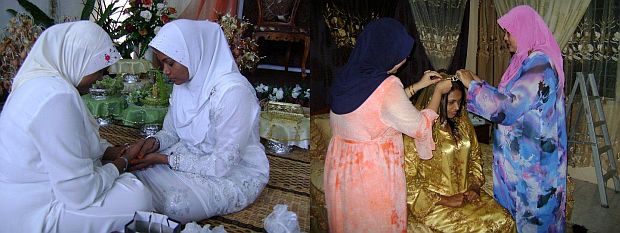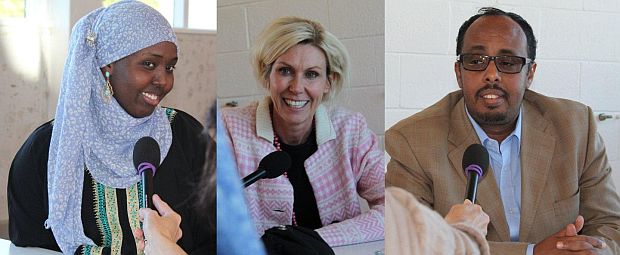Monday, 13 October 2014
"Female genital mutilation (FGM) is a complex and multifaceted practice, shrouded in mystery and taboo. Globally, an estimated 130 million women and girls have been affected, and the practice continues with an estimated two million girls a year at risk."
– FGM Education Programme (A guide for Health and Child Protection Professionals) for the New Zealand Ministry of Health
When does a cultural practice become a crime? When it breaches human rights and when it is culturally sanctioned – by individuals, cultures or faiths.
Syerina Syahrin is a PHD candidate at Victoria University in Wellington, and Muslim. She’s not afraid to speak out about her FGM experience, because (countering all expectations), she regards her experience as special. It was part of a celebratory age-old ritual performed by her grandmother back in her country of origin, Malaysia. Culturally embedded, Syerina remembers her occasion being a warm and loving one. A gathering of all close female relatives, a bath full of flowers, her grandmother performing the FGM, a sting like an ant bite and then treats of special yellow sticky rice made by her mother.

Left: A warm and close bond, Syerina's mother prepares her on her wedding day, photo courtesy Syerina Syahrin
Right: Syerina preparing for a traditional Islamic wedding, photo courtesy Syerina Syahrin
Perhaps that’s because what Syerina describes is “Type 1 FGM” where excision of the prepuce, with or without excision of part or all of the clitoris had taken place. Type 1 is the least “invasive” of the FGM types.
Arguably Type 1 FGM is similar to male circumcision (about one third of males world-wide are circumcised), a long accepted Judeo-Christian practice. Male circumcision has recently garnered its own disagreements within the world’s major medical organisations over the “health benefits” of the practice.
The Ministry of Health FGM Education Programme booklet lists the more extreme FGM types like this:
Type 2 – Excision of the clitoris with partial or total excision of the labia minora
Type 3 – excision of part or all of the external genitalia and stitching/narrowing of the vaginal opening (infibulation)
Dr Rose Elder is a gynaecologist with Wellington Hospital. She deals with women needing to have their extreme FGM (types 2 or 3) surgically corrected to help with pregnancy and child-birth, or to deal with serious complications such as urinary and pelvic infections. She says the FGM Education Programme is vital to aid health professionals like herself. The widely spread programme is also being used by Plunket nurses, school teachers, the NZ Police, CYFS and officers with the Department of Immigration across the country.
Nikki Denholm was the person responsible for creating the FGM Education Programme. She has a deep knowledge of African cultures, having worked as a health and humanitarian aid worker alongside her husband, in the Horn of Africa for over two decades.
She tells me that the programme was developed in the mid-1990s to service the influx of Somalian refugees at the time and because there was a massive dearth of knowledge and skill within the health sector. When 36 Somalian women turned up at Auckland’s hospitals with type 2 and 3 FGM none of our health professionals were prepared for the reality of this practice. Nikki was managing the Community Maternal Services at the time and was horrified at the lack of provisions or resources for caring for these women and girls.
So Nikki worked alongside a dynamic team of Somalian community leaders and members deeply opposed to FGM. This team worked to empower their own community to uphold important cultural practices without the need to involve FGM. Two members of this team were sitting with Nikki when we met in Auckland.
Ayan Said and Mahad Warsame are both from the Somalian community and deeply opposed to FGM. Nikki facilitated this meeting at her offices because she and Mahad have worked as a team for the last 12 years to turn the Somalian community around.
Community Leader Mahad Warsame tells me that it’s often not the men in the family trying to enforce FGM, but actually the elderly grandmothers, the matriarchs who perpetuate this cultural practice. “It comes from our own 'bad' culture. The men are trying to tell the grandmothers and mothers, don’t do this. We don’t want our girls to suffer.”
Mahad reiterated that as a community leader and a male, getting the message across to the matriarchy was the key to change and it had to be “strength-based education” – Somalian people telling each other about alternatives. Their girls don’t need FGM to be considered “pure” or “marriageable.” The message must come from role models and leaders within the ethnic minority communities in the first place. That’s where young women like Ayan come in: So it’s like an identity crisis basically – how do we define ourselves? There’s all these different reasons why people practice and a lot of people are still stuck with, 'Oh it’s part of our religious obligation' and it’s understanding that it isn’t.”
Ayan Said was born in Somalia. She came to New Zealand at the age of four and is currently completing her Master’s in Public Health focusing on FGM. She is a perfect educator for this cause, as a Muslim and a Somalian woman working within her own community.
Ayan and Mahad explain how FGM is not only a culturally embedded practice but also entrenched within how Somalian women perceive themselves. The key was changing these perceptions within their community. So far the FGM Education Programme has achieved spectacularly positive results, they have managed to turn around New Zealand Somalian community attitudes, with almost 100 percent of them no longer keen to perform FGM on their daughters or granddaughters.
Mahad tells me that in the early days of the FGM programme many African communities were in denial, for fear of stigmatising or shaming their community. The glare of mainstream media and a New Zealand public that just didn’t understand why FGM was so important created stigma and ghettoised the African communities. There’s nothing like “FGM” to get negative mainstream media attention. This approach will shut down the communities, rather than open them to education, understanding and rethinking how to value their culture without the ritual.

Left: Ayan Said, FGM Educator, Somalian Community, Middle: FGM Education Programme Producer, Nikki Denholm, Right: Mahad Warsame, Somalian Community Leader
The New Zealand Police are also very anxious that our ethnic communities are not negatively targeted by mainstream media. National Strategic Ethnic Advisor Inspector Rakesh Naidoo uses the FGM Education Programme as an excellent example of success, making real change for the ethnic communities here that used to practice FGM. If FGM survivors feel safe to disclose their situation to health professionals and pro-active action comes voluntarily from the communities then these groups will be open to education. The police are very keen to keep the trust of the community in this regard. They support the community’s efforts to combat culturally motivated crime from within.
Inspector Naidoo says that the FGM Education Programme is forging the way for positive change. It’s a great template programme that could be used to target other culturally motivated crimes. These kind of programmes show the wider public that our ethnic communities are owning these issues and trying to make changes for the better. “It’s a positive conversation – why does FGM take place and what is it that needs to take place to make sure it doesn’t happen in NZ.”
The police now conduct cultural education workshops for their staff to combat culturally sanctioned crime, whether these are committed in ignorance or wilfully. This kind of education is vital and needs multi-agency support, to avoid situations like the Department of Immigration unwittingly becoming agents in the perpetuation of abuse – such as when a girl might be taken overseas by her parents, back to their country of origin to have FGM performed on her.
As a result of this approach co-operation between police and community leaders is strengthened. It’s a win-win situation, young girls are safer from the ritual practice of FGM, because their family are educated by their own about other ways to celebrate and uphold their unique cultures.
Inspector Naidoo would like to see education within the judiciary as well to educate expert witnesses around issues of “shame” so as not to stigmatise the community. National media campaigns similar to the White Ribbon, Pacifika Proud or E Tu campaigns should also be created for our ethnic communities. “The need and demand is here right now.” His descriptions of what has worked and why show that solutions to FGM, forced and underage marriage ideally involve a combination of advocacy, education and clear legislation.
Links:
FGM Education Programme
NZ Police